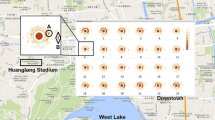Abstract
Learning more about human mobility is crucial for official decision makers and urban planners. Mobility datasets characterize human daily travel behaviors. Most current researches only studied human dynamics from one kind of mobility dataset. However, people may use different means of transportation to different places for different purposes. Besides, the spatial distributions of different types of point of interests (POIs) reflect the land-use types. How to jointly analyze the multi-source mobility datasets and POI information is a great challenge. In this paper, we adopt multi-source datasets, including taxi dataset, public bicycle system dataset and POI dataset, and propose a visual analytics methodology to explore human mobility dynamics insightfully. Two region–feature–time tensors are constructed first, and a tensor decomposition method is employed to classify the mobility patterns automatically. Then, a new POI–mobility glyph is designed to visualize multi-source datasets in a compact manner. Several interactive visual views are also designed to visualize the spatiotemporal patterns from global, regional and locational perspectives. Case studies based on real-world datasets demonstrate the effectiveness of our method, which supports the visual reasoning of trip purposes and mixed urban functions.
Graphic abstract















Similar content being viewed by others
References
Cao N, Lin C, Zhu Q et al (2018) Voila: visual anomaly detection and monitoring with streaming spatiotemporal data. IEEE Trans Vis Comput Graph 24(1):23–33
Chen W, Huang Z, Wu F et al (2018a) VAUD: a visual analysis approach for exploring spatio-temporal urban data. IEEE Trans Vis Comput Graph 24(9):2636–2648
Chen W, Xia J, Wang X et al (2018b) Relationlines: visual reasoning of egocentric relations from heterogeneous urban data. ACM Trans Intell Syst Technol 10(1):2
Ferreira N, Poco J, Vo HT et al (2013) Visual exploration of big spatio-temporal urban data: a study of New York city taxi trips. IEEE Trans Vis Comput Graph 19(12):2149–2158
Fishman E (2016) Bikeshare: a review of recent literature. Transp Rev 36(1):92–113
Gao S, Janowicz K, Couclelis H (2017) Extracting urban functional regions from points of interest and human activities on location-based social networks. Trans GIS 21(3):446–467
Han Y, Moutarde F (2016) Analysis of large-scale traffic dynamics in an urban transportation network using non-negative tensor factorization. Int J Intell Transp Syst Res 14(1):36–49
Kolda TG, Bader BW (2009) Tensor decompositions and applications. SIAM Rev 51(3):455–500
Liu D, Xu P, Ren L (2019) TPFlow: progressive partition and multidimensional pattern extraction for large-scale spatio-temporal data analysis. IEEE Trans Vis Comput Graph 25(1):1–11
Pei W, Wu Y, Wang S et al (2018) BVis: urban traffic visual analysis based on bus sparse trajectories. J Vis 21(5):873–883
Ran B, Tan H, Wu Y et al (2016) Tensor based missing traffic data completion with spatial–temporal correlation. Phys A 446:54–63
Shi X, Yu Z, Chen J et al (2018) The visual analysis of flow pattern for public bicycle system. J Vis Lang Comput 45:51–60
Shi X, Lv F, Seng D et al (2019) Exploring the evolutionary patterns of urban activity areas based on origin-destination data. IEEE Access 7:20416–20431
Tang Y, Sheng F, Zhang H et al (2018) Visual analysis of traffic data based on topic modeling. J Vis 21(4):661–680
Xie C, Zhong W, Xu W et al (2018) Visual analytics of heterogeneous data using hypergraph learning. ACM Trans Intell Syst Technol 10(1):4
Yan Y, Tao Y, Xu J et al (2018) Visual analytics of bike-sharing data based on tensor factorization. J Vis 21(3):495–509
Yang D, Zhang D, Zheng VW et al (2015) Modeling user activity preference by leveraging user spatial temporal characteristics in LBSNs. IEEE Trans Syst Man Cybern Syst 45(1):129–142
Yao Y, Li X, Liu X et al (2017) Sensing spatial distribution of urban land use by integrating points-of-interest and Google Word2Vec model. Int J Geogr Inf Sci 31(4):825–848
Yuan NJ, Zheng Y, Xie X et al (2015) Discovering urban functional zones using latent activity trajectories. IEEE Trans Knowl Data Eng 27(3):712–725
Zeng W, Fu CW, Arisona SM et al (2017) Visualizing the relationship between human mobility and points of interest. IEEE Trans Intell Transp Syst 18(8):2271–2284
Zhou Z, Yu J, Guo Z et al (2018) Visual exploration of urban functions via spatio-temporal taxi OD data. J Vis Lang Comput 48:169–177
Acknowledgements
This work was supported in part by the National Natural Science Foundation of China under Grant 61903109 and in part by the Zhejiang Provincial Natural Science Foundation of China under Grants LY19F020047 and LY17F020023.
Author information
Authors and Affiliations
Corresponding author
Additional information
Publisher's Note
Springer Nature remains neutral with regard to jurisdictional claims in published maps and institutional affiliations.
Rights and permissions
About this article
Cite this article
Shi, X., Lv, F., Seng, D. et al. Visual exploration of mobility dynamics based on multi-source mobility datasets and POI information. J Vis 22, 1209–1223 (2019). https://doi.org/10.1007/s12650-019-00594-1
Received:
Accepted:
Published:
Issue Date:
DOI: https://doi.org/10.1007/s12650-019-00594-1




